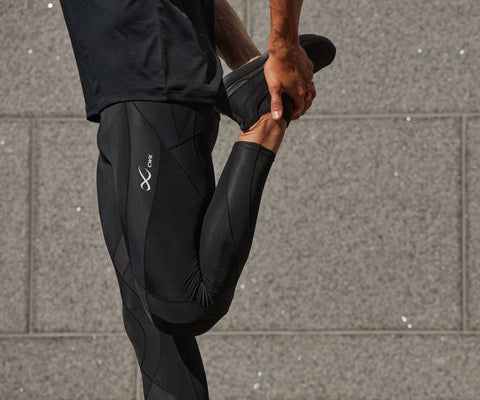Embarking on the journey of training for a marathon is both exhilarating and challenging. The satisfaction of conquering 26.2 miles is unparalleled, but it requires dedication, perseverance, and careful preparation — from perfecting your sleep patterns and nutrition to wearing the right clothing, like compression gear from CW-X, to ensure you're ready to go the distance.

Understanding the Basics of Marathon Training
Marathon training encompasses a mix of endurance runs, speed work, and recovery practices. Setting achievable goals based on your current fitness level, lifestyle, and time availability is crucial. Typically, marathon training requires several hours per week, balanced with other life responsibilities.
What Does Marathon Training Involve?
Marathon training involves a structured regimen of running workouts designed to build endurance and improve speed over time. It includes long runs, tempo runs, interval training, and recovery runs.
Setting Realistic Marathon Goals
Setting realistic goals is essential for a successful marathon experience. Goals should be specific, measurable, achievable, relevant, and time-bound (SMART), taking into account factors such as previous running experience and fitness level. You should also be prepared to work up to longer distances and faster times over several weeks — you can't go from 0 to 60 right away.
The Time Commitment for Marathon Success
Marathon training typically lasts between 16 to 20 weeks, depending on your fitness level and experience. Consistency is key, with gradual mileage increases over time to prevent injury.

Creating a Training Plan
A well-designed training plan integrates various types of runs, rest days, and cross-training activities. Long-distance runs play a crucial role in building endurance, while rest days are essential for recovery and injury prevention.
Crafting a Balanced Marathon Training Schedule
A balanced training schedule includes a mix of long runs, speed work, strength training, and rest days. It's important to listen to your body and adjust your training plan accordingly to avoid overtraining and burnout.
The Essential Role of Long Runs
Long runs are the cornerstone of marathon training, gradually increasing in distance to prepare the body for the demands of race day. They build endurance, mental toughness, and confidence.
Safely Increasing Mileage
Increasing mileage should be done gradually to prevent injury and allow the body to adapt to the demands of marathon training. A general guideline is to increase weekly mileage by no more than 10%.

Nutrition and Hydration Strategies
Proper nutrition and hydration are vital for supporting long runs and optimizing recovery. A balanced diet rich in carbohydrates, proteins, and healthy fats, along with adequate hydration, is key to fueling your runs and aiding in recovery.
Fueling Your Runs: Nutrition Tips for Endurance
During long runs, focus on consuming easily digestible carbohydrates to maintain energy levels. Experiment with different fueling strategies during training to find what works best for you.
Mastering Hydration: Before, During, and After Your Runs
Hydration before, during, and after runs is crucial for maintaining performance and preventing dehydration. Monitor your fluid intake and replenish electrolytes lost through sweat, being careful not to overdrink right before or during a workout to ensure your stomach isn't too full of fluid.
Electrolytes: Your Allies Against Cramps and Dehydration
Electrolytes play a vital role in muscle function and hydration. Incorporate electrolyte-rich foods — such as bananas, avocados, and peanuts — and sports drinks into your diet to prevent cramps and dehydration during long runs.

The Significance of Proper Running Gear
Investing in the right running gear, including shoes and compression wear, can enhance performance, comfort, and injury prevention. CW-X compression gear provides targeted support for muscles and joints, aiding in recovery and performance.
Selecting the Right Running Shoes for Peak Performance
Choosing the right running shoes is essential for preventing injuries and maximizing comfort and efficiency. Visit a specialty running store for a gait analysis to find the perfect fit for your feet, and be sure that your sneakers are worn before race day to avoid discomfort.
Enhancing Performance with CW-X Compression Gear
CW-X compression gear delivers advanced support and stability to help reduce muscle fatigue and promote faster recovery. Designed to optimize biomechanical efficiency, CW-X gear supports your body through every stride so you're always ready to reach the finish line.
While compression gear in general can benefit marathon runners, only CW-X apparel is powered by patented EXO-WEB™ technology, which mimics kinesiology taping to stabilize key joints and muscle groups without limiting range of motion. The result: better posture, improved alignment, and more efficient movement throughout your run.
Additional performance-enhancing features include:
- Multi-directional stretch fabric for flexible, body-hugging support
- WarmStretch™ material that regulates body temperature in all conditions
- Lower back and abdominal paneling to support the core during long-distance efforts
- Breathable, moisture-wicking fabric for lasting comfort
- Flat seam construction to help prevent chafing
From training runs to race day, CW-X compression gear is engineered to help you go farther, feel stronger, and recover faster.
Optimizing Recovery and Performance with CW-X
Wearing CW-X compression gear post-run enhances circulation and reduces muscle soreness, speeding up recovery so you're ready to hit the road again as soon as possible, therefore improving overall performance.
Must-Have Marathon Training Accessories
In addition to compression gear, essential accessories for marathon training include hydration solutions, nutrition carriers, and reflective gear for safety during early morning or evening runs.

Injury Prevention Techniques
Preventing injuries is crucial for maintaining consistency in training and achieving marathon goals. Incorporate stretching, strength training, and proper rest into your routine to improve flexibility, stability, and resilience.
Navigating Common Running Injuries: Prevention and Care
Common running injuries such as shin splints, IT band syndrome, and plantar fasciitis can be prevented or alleviated with proper warm-up, cooldown, and stretching routines. Listen to your body, resting when needed and seeking professional guidance if pain persists.
Tuning In: The Importance of Listening to Your Body
Listen to your body's signals during training and adjust your intensity and mileage accordingly. Rest and recovery are just as important as training runs in preventing burnout and injury.
Building a Stronger Runner: Stretching and Strength Training
Incorporate dynamic stretching and strength training exercises into your routine to improve flexibility, stability, and muscle strength. Focus on key areas such as the core, hips, and legs to support proper running form and reduce injury risk.

Mental Preparation and Motivation
Maintaining mental focus and motivation is essential during the rigorous marathon training process. Set clear, achievable goals, break the training cycle into manageable chunks, and celebrate milestones along the way to stay motivated and focused.
Overcoming the Mental Hurdles of Long Runs
During long runs, practice mental strategies such as positive self-talk, visualization, and breaking the distance into smaller segments to stay focused and motivated. You may also consider listening to music or a podcast to keep yourself from getting bored.
Milestones Matter: Setting and Achieving Personal Goals
It's important to set many small goals. Each time you go a new distance, conquer a different trail, or reach a time record, celebrate your wins and know you're one step closer to the finish line.

Recovery and Rest
Incorporating rest days and active recovery into your training plan is essential for allowing your body to repair and adapt to the demands of marathon training. Prioritize sleep to optimize physical and mental recovery.
Embracing the Power of Rest Days
Rest days are not a sign of weakness. In fact, they're a crucial component of effective training. Use rest days to recharge both physically and mentally, allowing your body to recover and adapt to the stresses of training.
Active Recovery: Enhancing Your Rest Days
Instead of ceasing all activity on off days, consider engaging in low-impact activities such as swimming, yoga, or cycling on rest days to promote blood flow, reduce muscle soreness, and enhance recovery. You might also consider fun sports like pickleball to mix up your regiment while staying mobile on active recovery days.
The Foundation of Recovery: Prioritizing Sleep
Quality sleep is essential for muscle repair, hormone regulation, and mental rejuvenation. Aim for seven to nine hours of uninterrupted sleep each night to support your marathon training goals.

Marathon Race Day Strategies
On race day, focus on maintaining a steady pace, staying hydrated, and fueling properly to avoid hitting the wall. Trust in your training, stay positive, and enjoy the experience of crossing the finish line.
The Final Countdown: Pre-Race Evening and Morning Rituals
In the days before your race, start eating more carbohydrates. The night before the marathon, lay out your gear, hydrate well, and eat a balanced meal that includes carbs and protein. On race morning, wake up early, eat a light breakfast that includes both carbs and protein (like eggs or peanut butter on toast), and arrive at the start line early relaxed and ready to run.
Pacing Yourself: Strategies to Prevent Hitting the Wall
Avoid starting too fast and burning out early in the race. Pace yourself according to your training and adjust as needed based on how you feel throughout the race, knowing you're only competing against yourself.
Fueling on the Fly: Hydration and Nutrition During the Marathon
For a mid-run pick-me-up, take small sips of water often throughout the race and fuel up with quickly digested carbs from gel packets or sports chews made especially for long-distance runners.
Training for a marathon is more than just hitting the pavement — it requires the right mindset, rest, nutrition, training, recovery time, and gear. With CW-X compression clothing as part of your marathon toolkit, you'll be off to a great start knowing that your apparel is up to the challenge and will help both your performance and recovery. Runners, get ready, get set, go!
